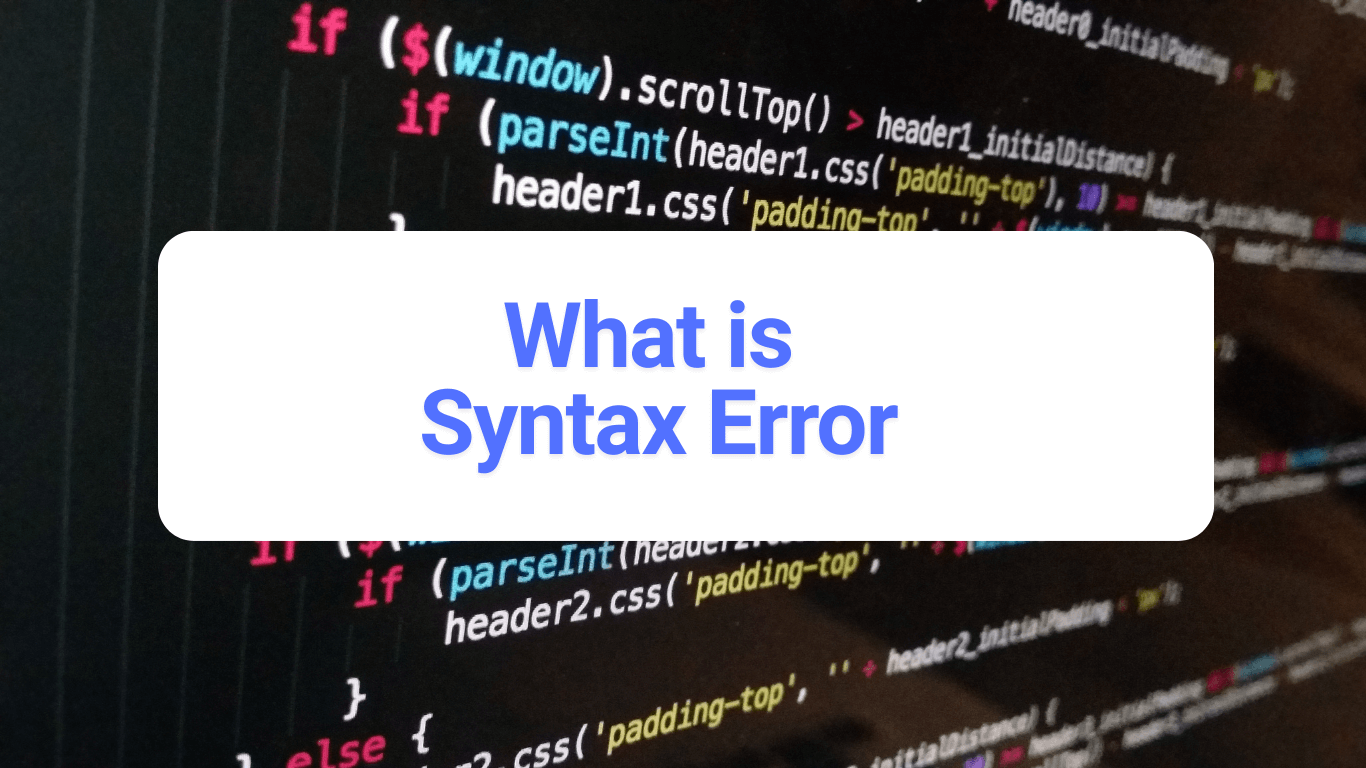A syntax error occurs when the code violates the grammatical rules of the programming language. These errors prevent the program from running.
Syntax errors are common in programming and can be frustrating for developers. They occur when the code does not follow the correct structure required by the programming language. This can include missing punctuation, incorrect keywords, or improper use of operators.
Identifying and fixing syntax errors is essential for the code to execute properly. Tools like compilers and interpreters are used to detect these errors, providing feedback to the programmer. By understanding the rules of the language and practicing good coding habits, developers can minimize syntax errors and improve their coding efficiency.

Credit: discuss.python.org
Introduction To Syntax Errors
Understanding syntax errors is crucial for any programmer. Beginners often face these errors. Let’s dive into what syntax errors are and why they’re important.
Definition
A syntax error occurs when the code violates the rules of the programming language. For example, missing a semicolon in JavaScript:
console.log("Hello World")
This code will throw a syntax error because it lacks a semicolon.
Importance In Coding
Syntax errors are essential to identify. They prevent code from running. Below are reasons why they’re important:
- Code Execution: Syntax errors stop the code from executing.
- Debugging: They help in finding mistakes early.
- Learning: Beginners learn proper coding rules.
Let’s look at a table for quick reference:
| Error Type | Example | Solution |
|---|---|---|
| Missing Semicolon | console.log("Hello World") | Add a semicolon: console.log("Hello World"); |
| Unclosed String | console.log("Hello World); | Close the string: console.log("Hello World"); |
Understanding these basics helps in writing better code. Avoiding syntax errors saves time and effort.

Credit: www.researchgate.net
Types Of Syntax Errors
Understanding the different types of syntax errors is crucial for any programmer. Syntax errors can be broadly classified into two main categories: compile-time errors and runtime errors. Each type has unique characteristics and implications. Let’s dive into these categories to understand them better.
Compile-time Errors
Compile-time errors occur during the compilation of the code. The compiler identifies these errors before the program runs. These errors prevent the code from executing.
Common causes include:
- Misspelled keywords
- Incorrect use of punctuation
- Mismatched braces
For example, a missing semicolon in C++:
#include
using namespace std;
int main() {
cout << "Hello, World!" // Missing semicolon here
return 0;
}
In this example, the compiler will flag the missing semicolon. The program will not run until you fix the error.
Runtime Errors
Runtime errors occur while the program is running. These errors are not detected by the compiler. They appear only when the code executes.
Common causes include:
- Division by zero
- Null pointer dereference
- Array index out of bounds
For example, a division by zero in Python:
def divide(a, b):
return a / b
result = divide(10, 0) # This will cause a runtime error
In this example, the program will crash at runtime due to division by zero. You must handle these errors using exception handling or other mechanisms.
Both compile-time and runtime errors are critical in programming. Understanding them helps you write better and more reliable code.
Common Syntax Mistakes
Syntax errors are common in programming. They occur when the code does not follow the language rules. These errors prevent the program from running correctly. Understanding common syntax mistakes helps in writing clean and error-free code.
Missing Semicolons
Missing semicolons is a frequent mistake in languages like JavaScript and C++. Semicolons are used to end statements. Forgetting a semicolon can cause unexpected issues.
Here’s an example in JavaScript:
let x = 5
let y = 10
console.log(x + y)
The correct way:
let x = 5;
let y = 10;
console.log(x + y);
Adding semicolons makes the code clear and avoids errors.
Mismatched Brackets
Mismatched brackets are another common syntax error. Brackets must always come in pairs. Missing or extra brackets can break the code.
Consider this Python example:
def sum(a, b):
return a + b
print(sum(5, 10)
The correct way:
def sum(a, b):
return a + b
print(sum(5, 10))
Always check for matching brackets to ensure code runs smoothly.
Language-specific Errors
Each programming language has its own syntax rules. These rules must be followed to avoid syntax errors. Syntax errors occur when the code does not conform to the language’s grammar rules. Let’s explore common syntax errors in Python and JavaScript.
Python Errors
Python is known for its simple syntax. But it still has common errors:
- Indentation Errors: Python uses indentation to define blocks of code. Missing or extra spaces cause errors.
- Missing Colons: Colons are required after statements like
if,for, anddef. - Incorrect Variable Names: Variable names must start with a letter or underscore. Numbers and special characters cause errors.
Example of a Python syntax error:
if x == 5
print("x is 5")
In this example, the colon is missing after if x == 5.
Javascript Errors
JavaScript has its own set of common syntax errors:
- Missing Semicolons: While optional, semicolons help avoid errors. They separate statements.
- Unmatched Brackets: Every opening bracket
{must have a closing bracket}. - Incorrect Function Syntax: Functions must be defined correctly with
functionkeyword and parentheses.
Example of a JavaScript syntax error:
function myFunction() {
console.log("Hello World"
}
In this example, the closing parenthesis is missing after "Hello World".
Debugging Techniques
Debugging syntax errors can be challenging. This section covers effective techniques to debug these errors. Understanding the error messages and performing a code review are critical steps.
Error Messages
Error messages provide clues about the issue. They often point to the exact line with the error. Here are some tips for reading error messages:
- Read the entire message: Don’t just skim the error message. Read it fully.
- Look at the line number: The message usually shows where the error is.
- Understand common errors: Syntax errors often come from missing semicolons, brackets, or incorrect variable names.
Consider this Python example:
print("Hello World"
The error message will likely state:
SyntaxError: unexpected EOF while parsing
This message indicates a missing closing parenthesis.
Code Review
Conducting a thorough code review can help find syntax errors. Here are some steps for an effective code review:
- Check for common mistakes: Look for missing semicolons, mismatched brackets, and typos.
- Read code line by line: Go through each line to ensure it follows syntax rules.
- Use a linter: Linters automatically check your code for syntax errors.
A linter example for JavaScript:
eslint yourfile.js
This command will highlight syntax issues in your code.
Debugging syntax errors requires attention to detail. Using error messages and performing code reviews are key strategies. These techniques will help you identify and fix errors efficiently.
Tools For Detecting Errors
Detecting syntax errors is crucial for developers. Syntax errors can cause programs to fail. Fortunately, there are tools to help identify these errors early. These tools improve code quality and efficiency.
Linters
Linters analyze code for potential errors. They check for syntax errors and coding style issues. Linters are essential for maintaining clean code.
Popular linters include:
Linters integrate easily with text editors and IDEs. They provide instant feedback on code issues. This helps developers correct mistakes quickly.
Integrated Development Environments (ides)
Integrated Development Environments (IDEs) offer comprehensive tools for coding. They include features for writing, testing, and debugging code.
Popular IDEs include:
- Visual Studio Code
- PyCharm
- IntelliJ IDEA
IDEs highlight syntax errors in real-time. This makes error detection faster and easier. They also provide suggestions to fix errors.
Using IDEs can significantly reduce development time. They offer a unified environment for all coding tasks.
Best Practices
Understanding the best practices for avoiding syntax errors is crucial. Syntax errors can cause programs to crash or behave unpredictably. By following best practices, you can write cleaner and more reliable code.
Consistent Formatting
Consistent formatting helps your code become more readable. It also reduces the chance of syntax errors. Follow these tips for better formatting:
- Use indentation consistently. Indent your code to show its structure.
- Keep your line lengths short. Aim for 80 characters per line.
- Always use the same naming conventions. For example, use camelCase for variables.
Here’s an example of well-formatted code:
function addNumbers(a, b) {
let sum = a + b;
return sum;
}
Bad formatting can hide errors. Always format your code consistently.
Commenting Code
Commenting your code helps others understand it. It also helps you remember what your code does. Follow these tips for effective commenting:
- Use inline comments sparingly. Only comment on complex lines of code.
- Write block comments to describe a section of code. Explain its purpose and logic.
- Keep your comments clear and concise. Avoid writing long paragraphs.
Here’s an example of good commenting:
// This function adds two numbers
function addNumbers(a, b) {
// Calculate the sum of a and b
let sum = a + b;
return sum; // Return the sum
}
Comments should help, not confuse. Write them wisely.

Credit: realpython.com
Real-world Examples
Syntax errors are common mistakes in programming. They occur when the code doesn’t follow language rules. Understanding syntax errors with real-world examples helps learners avoid them.
Case Studies
Let’s dive into real-world examples of syntax errors. These case studies highlight common mistakes.
Example 1: Missing Parentheses in Python
In Python, forgetting a parenthesis is a common error.
print "Hello, World!"The correct syntax should be:
print("Hello, World!")Example 2: Missing Semicolon in JavaScript
JavaScript requires semicolons to terminate statements.
let message = "Hello, World!"The correct syntax should be:
let message = "Hello, World!";Common Pitfalls
Programmers often face these common pitfalls. Avoiding them ensures smoother coding.
- Misspelling Keywords: Writing
prininstead ofprint. - Improper Indentation: In Python, wrong indentation causes errors.
- Unmatched Brackets: Forgetting to close brackets or braces in code.
A summary table of common pitfalls:
| Language | Common Error |
|---|---|
| Python | Missing Parentheses |
| JavaScript | Missing Semicolon |
| Any Language | Misspelling Keywords |
Frequently Asked Questions
What Is A Syntax Error In Programming?
A syntax error occurs when code violates the rules of a programming language. It prevents the program from running.
How Do Syntax Errors Affect Code?
Syntax errors stop code from executing correctly. They need fixing before the program runs.
What Causes Syntax Errors?
Syntax errors are caused by incorrect language use, such as missing brackets or semicolons.
How Can Syntax Errors Be Fixed?
Syntax errors are fixed by correcting the code to follow proper language rules. Debugging tools help.
Conclusion
Understanding syntax errors is crucial for efficient coding. They disrupt code execution and must be fixed promptly. Recognize common syntax errors to enhance coding skills. Practice consistently to minimize errors. Stay updated with coding guidelines for better error management. This approach ensures smoother, more productive programming sessions.






